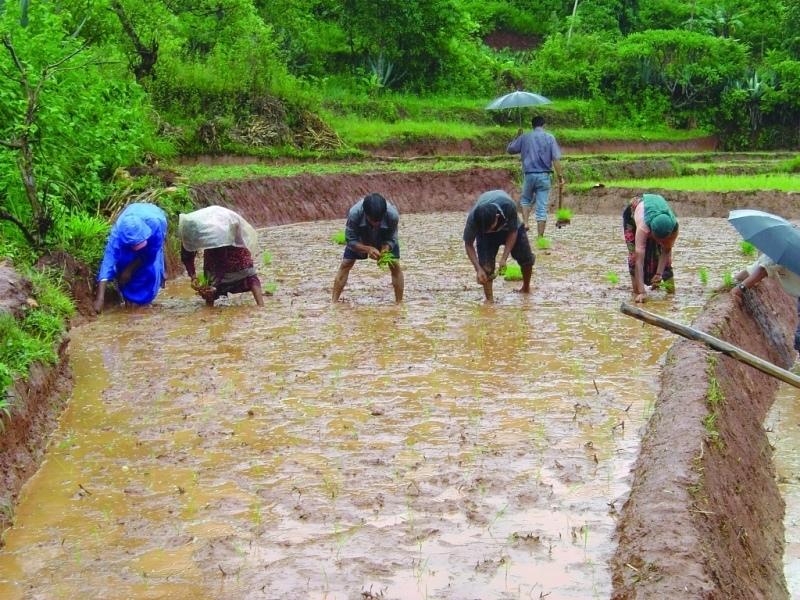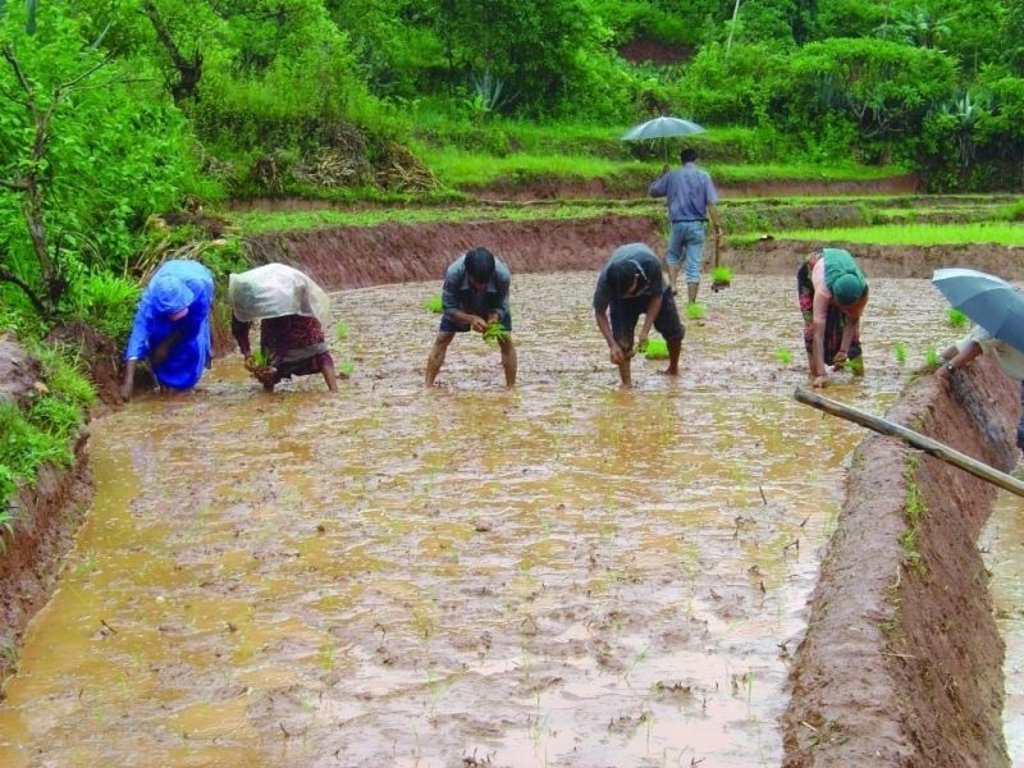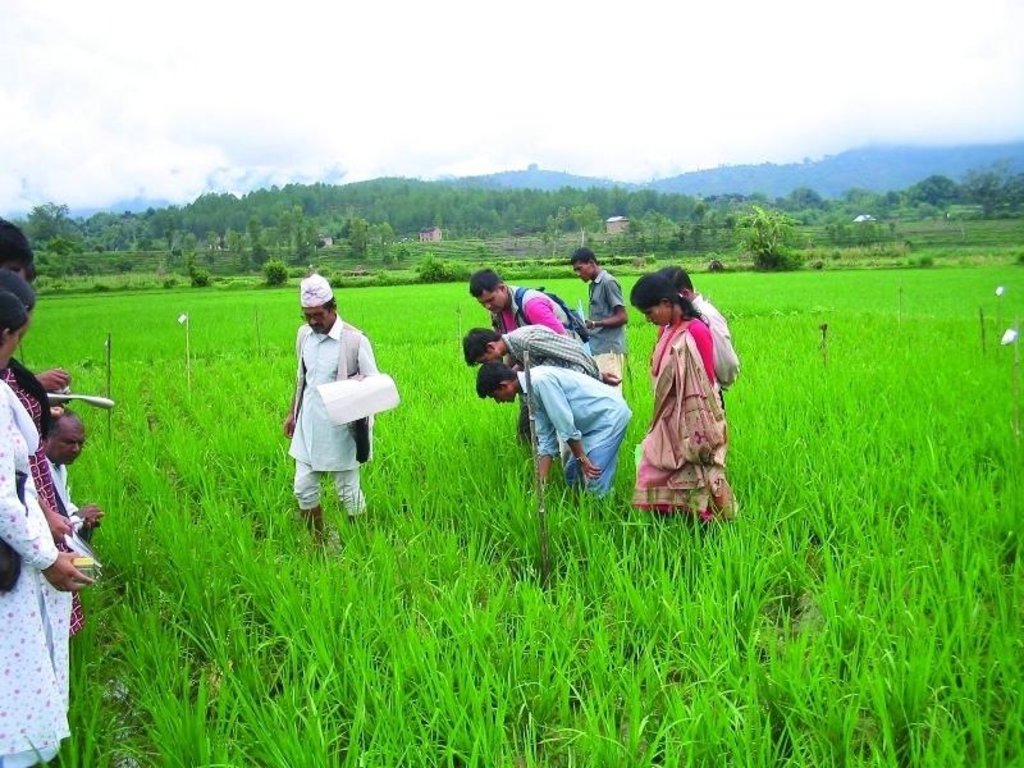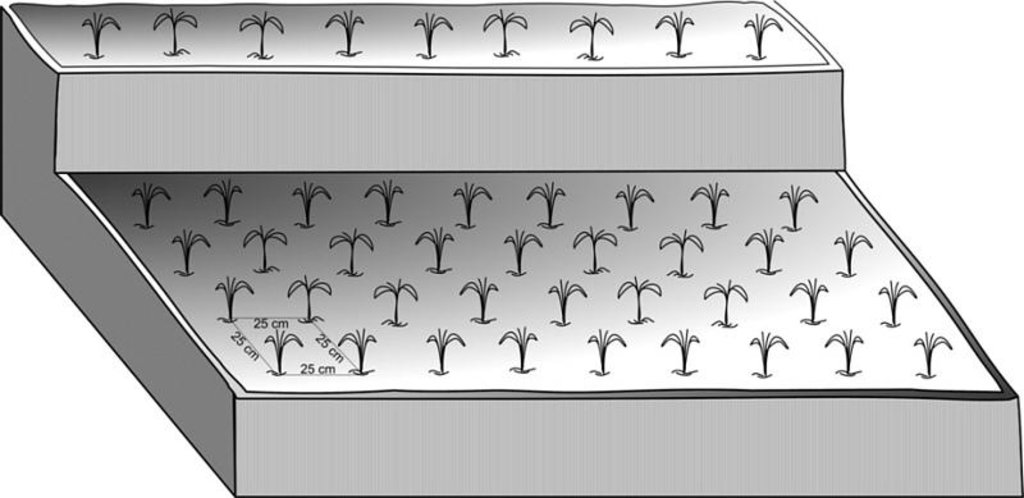System of Rice Intensification [เนปาล]
- ผู้สร้างสรรค์:
- การอัพเดท:
- ผู้รวบรวม: Madhav Dhakal
- ผู้เรียบเรียง: –
- ผู้ตรวจสอบ: David Streiff, Alexandra Gavilano
Dhan uttapadan bridi garne tarika - Nepali
technologies_1494 - เนปาล
ดูส่วนย่อย
ขยายทั้งหมด ย่อทั้งหมด1. ข้อมูลทั่วไป
1.2 รายละเอียดที่ติดต่อได้ของผู้รวบรวมและองค์กรที่เกี่ยวข้องในการประเมินและการจัดเตรียมทำเอกสารของเทคโนโลยี
ผู้เชี่ยวชาญ SLM:
ผู้เชี่ยวชาญ SLM:
ผู้เชี่ยวชาญ SLM:
ชื่อขององค์กรซึ่งอำนวยความสะดวกในการทำเอกสารหรือการประเมินเทคโนโลยี (ถ้าเกี่ยวข้อง)
ICIMOD International Centre for Integrated Mountain Development (ICIMOD) - เนปาล1.3 เงื่อนไขการใช้ข้อมูลที่ได้บันทึกผ่านทาง WOCAT
ผู้รวบรวมและวิทยากรหลักยอมรับเงื่อนไขเกี่ยวกับการใช้ข้อมูลที่ถูกบันทึกผ่านทาง WOCAT:
ใช่
1.5 Reference to Questionnaire(s) on SLM Approaches (documented using WOCAT)
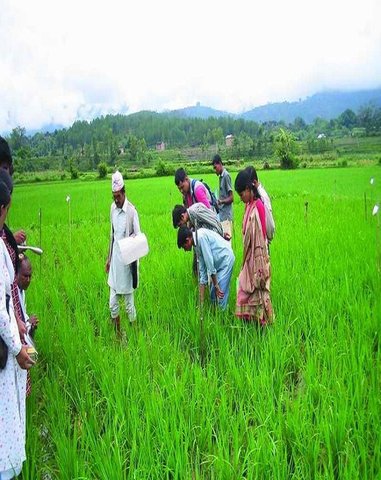
Evaluation of the System of Rice Intensification through … [เนปาล]
Conducting participatory action research with farmers and district level line agencies for demonstrating, disseminating and scaling up SRI
- ผู้รวบรวม: Madhav Dhakal
2. การอธิบายลักษณะของเทคโนโลยี SLM
2.1 การอธิบายแบบสั้น ๆ ของเทคโนโลยี
คำจำกัดความของเทคโนโลยี:
A method for increasing the productivity of rice by changing the management of plants, soil, water, and nutrients.
2.2 การอธิบายแบบละเอียดของเทคโนโลยี
คำอธิบาย:
The System of Rice Intensification (SRI) was developed in Madagascar by Henri de Laulanie, in the 1980s. He worked with Malagasy farmers and colleagues to improve the possibilities of rice production. The practice contributes to both healthier soil and healthier plants, supported by greater root growth and the nurturing of soil microbial abundance and diversity. It is based on a number of well-founded agro-ecological principles. SRI concepts and practices have also been successfully adapted to upland rice.
SRI involves transplanting very young rice seedlings (usually 8-12 days old with just two small leaves) carefully and quickly so as to cause minimum disturbance to the roots. The seedlings are planted individually, in contrast to the traditional method where clumps of 3-4 are planted together, minimising root competition between the seedlings. The seedlings are kept widely spaced to allow better root and canopy growth, in a square grid pattern at a spacing of at least 25 x 25 cm. Planting can be done even wider at 30 x 30 or 40 x 40 cm and even up to 50 x 50 cm in the best quality soils.
The soil is kept moist but well drained and aerated to support increased biological activity. A small quantity of water is applied during the vegetative growth period following which a thin layer of water is maintained on the fields only during the flowering and grain-filling stages. Better quality compost, such as well decomposed farmyard manure, can be applied to achieve additional yield increases. Since weed growth will be more abundant and will be a problem in fields that are not kept flooded (and because of the wider spacing), weeding needs to be done at least once or twice in the first 10-12 days and a total of three or four times altogether before the canopy closes.
SRI does not require additional inputs like new seeds, chemical fertiliser or pesticides, but it does require the skilful management of the factors in production and, at least initially, 25-50% more labour inputs, particularly for the transplanting and weeding. As farmers become more skilled and confident in SRI, the amount of labour needed decreases and can eventually become the same or even less than with conventional methods.
SRI is being tried out by farmers in many areas of Nepal’s middle mountains including in the Jhikhu Khola watershed. This area has an altitude of 800-2200 masl, and receives about 1200 mm annual rainfall, about 70-80% in the monsoon months (June to September).
2.3 รูปภาพของเทคโนโลยี
2.5 ประเทศภูมิภาค หรือสถานที่ตั้งที่เทคโนโลยีได้นำไปใช้และได้รับการครอบคลุมโดยการประเมินนี้
ประเทศ:
เนปาล
ข้อมูลจำเพาะเพิ่มเติมของสถานที่ตั้ง :
Kavre palanchowk/Jhikhu Khola watershed
ระบุการกระจายตัวของเทคโนโลยี:
- กระจายไปอย่างสม่ำเสมอในพื้นที่
If precise area is not known, indicate approximate area covered:
- < 0.1 ตร.กม.(10 เฮกตาร์)
แสดงความคิดเห็น:
This was the first year of on farm research cum demonstration on the farmers field after the trial in the research station. Six farmers tested SRI in 2003. It was tested in Panchkhal, Hokse, Bhimsensthan, Baluwa, and Patalekhet VDCs.
Map
×2.6 วันที่การดำเนินการ
ถ้าไม่รู้ปีที่แน่นอน ให้ระบุวันที่โดยประมาณ:
- น้อยกว่า 10 ปี (ไม่นานนี้)
2.7 คำแนะนำของเทคโนโลยี
ให้ระบุว่าเทคโนโลยีถูกแนะนำเข้ามาอย่างไร:
- ทางโครงการหรือจากภายนอก
ความคิดเห็น (ประเภทของโครงการ เป็นต้น) :
Madagascar
3. การจัดประเภทของเทคโนโลยี SLM
3.1 วัตถุประสงค์หลักของเทคโนโลยี
- ปรับปรุงการผลิตให้ดีขึ้น
3.2 ประเภทของการใช้ที่ดินในปัจจุบันที่ได้นำเทคโนโลยีไปใช้

พื้นที่ปลูกพืช
- การปลูกพืชล้มลุกอายุปีเดียว
Annual cropping - Specify crops:
- cereals - maize
- vegetables - other
- rice, wheat
จำนวนของฤดูเพาะปลูกต่อปี:
- 3
ระบุ:
Longest growing period in days: 150; Longest growing period from month to month: Jun - Oct; Second longest growing period in days: 120; Second longest growing period from month to month: Nov - Feb
แสดงความคิดเห็น:
major cash crop: Vegetables
major food crop: Rice
other: Maize, wheat
Major land use problems (compiler’s opinion): Limited production due to soil fertility decline, increased amount of agrochemical inputs and lack of sufficient irrigation water and irrigation infrastructures.
Major land use problems (land users’ perception): Decreased production, lack of irrigation facilities and increased amount of chemical fertilizers.
3.4 การใช้น้ำ
การใช้น้ำของที่ดินที่มีการใช้เทคโนโลยีอยู่:
- น้ำฝนร่วมกับการชลประทาน
3.5 กลุ่ม SLM ที่ตรงกับเทคโนโลยีนี้
- มาตรการหลังเก็บเกี่ยว
3.6 มาตรการ SLM ที่ประกอบกันเป็นเทคโนโลยี

มาตรการอนุรักษ์ด้วยการจัดการ
- M2: การเปลี่ยนแปลงของการจัดการหรือระดับความเข้มข้น
3.7 รูปแบบหลักของการเสื่อมโทรมของที่ดินที่ได้รับการแก้ไขโดยเทคโนโลยี

การเสื่อมโทรมของดินทางด้านเคมี
- Cn (Fertility decline): ความอุดมสมบูรณ์และปริมาณอินทรียวัตถุในดินถูกทำให้ลดลงไป (ไม่ได้เกิดจากสาเหตุการกัดกร่อน)
แสดงความคิดเห็น:
Main causes of degradation: urbanisation and infrastructure development (poor irrigation infrastructures), other natural causes (avalanches, volcanic eruptions, mud flows, highly susceptible natural resources, extreme topography, etc.) specify (uneven distribution of precipitation throughout the year), land tenure (population growth, separating famility members from a household.), labour availability (out migration for a off-farm employment)
Secondary causes of degradation: other human induced causes (specify) (Weak institutional collaboration), poverty / wealth (lack of government subsidy on agricultural sector), education, access to knowledge and support services (lack of sufficient discussion with concerned technicians and experienced farmers.)
3.8 การป้องกัน การลดลง หรือการฟื้นฟูความเสื่อมโทรมของที่ดิน
ระบุเป้าหมายของเทคโนโลยีกับความเสื่อมโทรมของที่ดิน:
- ลดความเสื่อมโทรมของดิน
4. ข้อมูลจำเพาะด้านเทคนิค กิจกรรมการนำไปปฏิบัติใช้ ปัจจัยนำเข้า และค่าใช้จ่าย
4.1 แบบแปลนทางเทคนิคของเทคโนโลยี
ข้อมูลจำเพาะด้านเทคนิค (แบบแปลนทางเทคนิคของเทคโนโลยี):
In the SRI method young seedlings (8-12 days old) are planted singly at a wide spacing of 25 x 25 cm or more
Technical knowledge required for field staff / advisors: moderate
Technical knowledge required for land users: low
Main technical functions: improved plant management, improved soil management, improved water management
Secondary technical functions: increase in organic matter, increase in soil fertility
Change of land use practices / intensity level: Planting method, irrigation method and soil fertility management is carriedout differently compare to traditional method.
ผู้เขียน:
Madhav Dhakal , A. K. Thaku
4.2 ข้อมูลทั่วไปเกี่ยวกับการคำนวณปัจจัยนำเข้าและค่าใช้จ่าย
ให้ระบุว่าค่าใช้จ่ายและปัจจัยนำเข้าได้รับการคำนวณอย่างไร:
- ต่อพื้นที่ที่ใช้เทคโนโลยี
ระบุขนาดและหน่วยพื้นที่:
1 ha
ระบุสกุลเงินที่ใช้คำนวณค่าใช้จ่าย:
- USD
ระบุค่าเฉลี่ยของค่าจ้างในการจ้างแรงงานต่อวัน:
2.10
4.4 ค่าใช้จ่ายของปัจจัยนำเข้าที่จำเป็นสำหรับการจัดตั้ง
แสดงความคิดเห็น:
Duration of establishment phase: 0 month(s)
4.5 การบำรุงรักษาสภาพหรือกิจกรรมที่เกิดขึ้นเป็นประจำ
| กิจกรรม | ช่วงระยะเวลา/ความถี่ | |
|---|---|---|
| 1. | Application of fertilizer | |
| 2. | Application of pesticides ( if required) | |
| 3. | Transplantation | monsoon, 8 to 12 days after seed sowing / |
| 4. | Irrigation of the mainfield ( to keep fields alternately dry and moist) | vegetative period / weekly after transplantation; |
| 5. | Weeding | vegetative period / 3-4 times; first within 10 day |
| 6. | Harvesting | October/November / |
| 7. | Nursery bed preparation, seed treatment and sowing | Beginning of monsoon / |
| 8. | Main field preparation ( ploughing and leveling) | Beginning of monsoon / |
4.6 ค่าใช้จ่ายของปัจจัยนำเข้าและกิจกรรมที่เกิดขึ้นเป็นประจำที่ต้องการการบำรุงรักษา (ต่อปี)
| ปัจจัยนำเข้า | หน่วย | ปริมาณ | ค่าใช้จ่ายต่อหน่วย | ค่าใช้จ่ายทั้งหมดต่อปัจจัยนำเข้า | %ของค่าใช้จ่ายที่ก่อให้เกิดขึ้นโดยผู้ใช้ที่ดิน | |
|---|---|---|---|---|---|---|
| แรงงาน | Maintaining field | Persons/day | 353.0 | 2.1 | 741.3 | 100.0 |
| อุปกรณ์ | Machin use | ha | 1.0 | 136.0 | 136.0 | 100.0 |
| วัสดุด้านพืช | Seeds | ha | 1.0 | 4.0 | 4.0 | 100.0 |
| ปุ๋ยและสารฆ่า/ยับยั้งการเจริญเติบโตของสิ่งมีชีวิต (ไบโอไซด์) | Fertilizer | ha | 1.0 | 94.0 | 94.0 | 100.0 |
| ปุ๋ยและสารฆ่า/ยับยั้งการเจริญเติบโตของสิ่งมีชีวิต (ไบโอไซด์) | Biocoides | ha | 1.0 | 56.0 | 56.0 | 100.0 |
| ค่าใช้จ่ายทั้งหมดของการบำรุงรักษาสภาพเทคโนโลยี | 1031.3 | |||||
| Total costs for maintenance of the Technology in USD | 1031.3 | |||||
แสดงความคิดเห็น:
labour: person -day, cost of agrochemicals
All costs were estimated in 2006.
4.7 ปัจจัยสำคัญที่สุดที่มีผลกระทบต่อค่าใช้จ่าย
ปัจจัยสำคัญที่สุดที่มีผลกระทบต่อค่าใช้จ่ายต่างๆ:
Due to increased off-farm employment trend , there is lack of manpower for field operation, which increases the labour cost .
5. สิ่งแวดล้อมทางธรรมชาติและของมนุษย์
5.1 ภูมิอากาศ
ฝนประจำปี
- < 250 ม.ม.
- 251-500 ม.ม.
- 501-750 ม.ม.
- 751-1,000 ม.ม.
- 1,001-1,500 ม.ม.
- 1,501-2,000 ม.ม.
- 2,001-3,000 ม.ม.
- 3,001-4,000 ม.ม.
- > 4,000 ม.ม.
ระบุปริมาณน้ำฝนเฉลี่ยรายปี (ถ้ารู้) :หน่วย ม.ม.
1200.00
เขตภูมิอากาศเกษตร
- ชื้น
Thermal climate class: subtropics
5.2 สภาพภูมิประเทศ
ค่าเฉลี่ยความลาดชัน:
- ราบเรียบ (0-2%)
- ลาดที่ไม่ชัน (3-5%)
- ปานกลาง (6-10%)
- เป็นลูกคลื่น (11-15%)
- เป็นเนิน (16-30%)
- ชัน (31-60%)
- ชันมาก (>60%)
ธรณีสัณฐาน:
- ที่ราบสูง/ที่ราบ
- สันเขา
- ไหล่เขา
- ไหล่เนินเขา
- ตีนเนิน
- หุบเขา
ระดับความสูง:
- 0-100 เมตร
- 101-500 เมตร
- 501-1,000 เมตร
- 1,001-1,500 เมตร
- 1,501-2,000 เมตร
- 2,001-2,500 เมตร
- 2,501-3,000 เมตร
- 3,001-4,000 เมตร
- > 4,000 เมตร
ความคิดเห็นและข้อมูลจำเพาะเพิ่มเติมเรื่องสภาพภูมิประเทศ:
Landforms: Also hill slopes
5.3 ดิน
ค่าเฉลี่ยความลึกของดิน:
- ตื้นมาก (0-20 ซ.ม.)
- ตื้น (21-50 ซ.ม.)
- ลึกปานกลาง (51-80 ซ.ม.)
- ลึก (81-120 ซ.ม.)
- ลึกมาก (>120 ซ.ม.)
เนื้อดิน (ดินชั้นบน):
- ปานกลาง (ดินร่วน ทรายแป้ง)
- ละเอียด/หนัก (ดินเหนียว)
อินทรียวัตถุในดิน:
- ปานกลาง (1-3%)
- ต่ำ (<1%)
(ถ้ามี) ให้แนบคำอธิบายเรื่องดินแบบเต็มหรือระบุข้อมูลที่มีอยู่ เช่น ชนิดของดิน ค่า pH ของดินหรือความเป็นกรดของดิน ความสามารถในการแลกเปลี่ยนประจุบวก ไนโตรเจน ความเค็ม เป็นต้น:
Soil depth on average: Variable
Soil fertility is very low - low
Soil drainage / infiltration is medium - poor
Soil water storage capacity is medium
5.4 ความเป็นประโยชน์และคุณภาพของน้ำ
คุณภาพน้ำ (ที่ยังไม่ได้บำบัด):
เป็นน้ำเพื่อการดื่มที่ไม่ดี (จำเป็นต้องได้รับการบำบัด)
ความคิดเห็นและข้อมูลจำเพาะเพิ่มเติมเรื่องคุณภาพและปริมาณน้ำ:
Availability of surface water: Maximum during rainy season (June to september), starts decresing from October reaching minimum in April/May
Water quality (untreated): Poor more in rainy season (June- September), less in April/May, but otherwise good drinking water
5.6 ลักษณะของผู้ใช้ที่ดินที่นำเทคโนโลยีไปปฏิบัติใช้
แนวทางการตลาดของระบบการผลิต:
- เพื่อการยังชีพ (หาเลี้ยงตนเอง)
รายได้ที่มาจากนอกฟาร์ม:
- 10-50% ของรายได้ทั้งหมด
ระดับของความมั่งคั่งโดยเปรียบเทียบ:
- จน
- พอมีพอกิน
เป็นรายบุคคล/ครัวเรือน:
- เป็นรายบุคคล/ครัวเรือน
ระดับของการใช้เครื่องจักรกล:
- งานที่ใช้แรงกาย
- การใช้กำลังจากสัตว์
เพศ:
- หญิง
- ชาย
ระบุลักษณะอื่นๆที่เกี่ยวข้องของผู้ใช้ที่ดิน:
Land users applying the Technology are mainly common / average land users
Population density: 200-500 persons/km2
Annual population growth: 2% - 3%
15% of the land users are rich and own 35% of the land.
35% of the land users are average wealthy and own 40% of the land.
50% of the land users are poor and own 25% of the land.
Off-farm income specification: In most farm households, off-farm income plays at least a minor and increasingly a major role. Occasional opportunities for off-farm income present themselves in the form of daily
Level of mechanization: Manual labour for planting, irrigation, harvesting, animals are used for field preparation and machines as well but in the valley bottom.
5.7 Average area of land used by land users applying the Technology
- < 0.5 เฮกตาร์
- 0.5-1 เฮกตาร์
- 1-2 เฮกตาร์
- 2-5 เฮกตาร์
- 5-15 เฮกตาร์
- 15-50 เฮกตาร์
- 50-100 เฮกตาร์
- 100-500 เฮกตาร์
- 500-1,000 เฮกตาร์
- 1,000-10,000 เฮกตาร์
- >10,000 เฮกตาร์
พิจารณาว่าเป็นขนาดเล็ก กลาง หรือขนาดใหญ่ (ซึ่งอ้างอิงถึงบริบทระดับท้องถิ่น):
- ขนาดเล็ก
5.8 กรรมสิทธิ์ในที่ดิน สิทธิในการใช้ที่ดินและสิทธิในการใช้น้ำ
กรรมสิทธิ์ในที่ดิน:
- รายบุคคล ได้รับสิทธิครอบครอง
สิทธิในการใช้ที่ดิน:
- รายบุคคล
สิทธิในการใช้น้ำ:
- เกี่ยวกับชุมชน (ถูกจัดระเบียบ)
6. ผลกระทบและสรุปคำบอกกล่าว
6.1 ผลกระทบในพื้นที่ดำเนินการ (On-site) จากการใช้เทคโนโลยี
ผลกระทบทางด้านเศรษฐกิจและสังคม
การผลิต
การผลิตพืชผล
แสดงความคิดเห็น/ระบุ:
10 - 57 percent grain yield increased
การผลิตพืชที่ใช้เลี้ยงปศุสัตว์
แสดงความคิดเห็น/ระบุ:
3 - 40 percent above ground bio -mass increased
คุณภาพพืชที่ใช้เลี้ยงปศุสัตว์
แสดงความคิดเห็น/ระบุ:
3 - 40 percent above ground bio -mass increased
รายได้และค่าใช้จ่าย
รายได้จากฟาร์ม
แสดงความคิดเห็น/ระบุ:
due to increased grain and biomass; seed , fertilizer, and labour saving,
ภาระงาน
แสดงความคิดเห็น/ระบุ:
only the first weeding is labour intensive
ผลกระทบด้านสังคมวัฒนธรรมอื่น ๆ
สถาบันของชุมชน
แสดงความคิดเห็น/ระบุ:
planning, discussing in a group and implementing the method systematically
SLM หรือความรู้เรื่องความเสื่อมโทรมของที่ดิน
แสดงความคิดเห็น/ระบุ:
use of organic fertilizer, reduced chemical fertilizer application, different method of irrigation management adopted
livelihood and human well-being
แสดงความคิดเห็น/ระบุ:
due to increased yield
ผลกระทบด้านนิเวศวิทยา
ผลกระทบด้านนิเวศวิทยาอื่น ๆ
soil fertility
แสดงความคิดเห็น/ระบุ:
use of organic fertilizer, reduced chemical fertilizer application
6.2 ผลกระทบนอกพื้นที่ดำเนินการ (Off-site) จากการใช้เทคโนโลยี
น้ำที่ใช้ประโยชน์ได้
แสดงความคิดเห็น/ระบุ:
more irrigation water available for downstream, because SRI uses less water than traditional method
6.3 การเผชิญและความตอบสนองของเทคโนโลยีต่อการเปลี่ยนแปลงสภาพภูมิอากาศที่ค่อยเป็นค่อยไป และสภาพรุนแรงของภูมิอากาศ / ภัยพิบัติ (ที่รับรู้ได้โดยผู้ใช้ที่ดิน)
การเปลี่ยนแปลงสภาพภูมิอากาศที่ค่อยเป็นค่อยไป
การเปลี่ยนแปลงสภาพภูมิอากาศที่ค่อยเป็นค่อยไป
| ฤดู | increase or decrease | เทคโนโลยีมีวิธีการรับมืออย่างไร | |
|---|---|---|---|
| อุณหภูมิประจำปี | เพิ่มขึ้น | ดี |
สภาพรุนแรงของภูมิอากาศ (ภัยพิบัติ)
ภัยพิบัติทางอุตุนิยมวิทยา
| เทคโนโลยีมีวิธีการรับมืออย่างไร | |
|---|---|
| พายุฝนประจำท้องถิ่น | ไม่ค่อยดี |
| พายุลมประจำท้องถิ่น | ไม่ค่อยดี |
ภัยพิบัติจากสภาพภูมิอากาศ
| เทคโนโลยีมีวิธีการรับมืออย่างไร | |
|---|---|
| ภัยจากฝนแล้ง | ไม่ค่อยดี |
ภัยพิบัติจากน้ำ
| เทคโนโลยีมีวิธีการรับมืออย่างไร | |
|---|---|
| น้ำท่วมตามปกติ (แม่น้ำ) | ไม่ค่อยดี |
ผลลัพธ์ตามมาที่เกี่ยวข้องกับภูมิอากาศอื่น ๆ
ผลลัพธ์ตามมาที่เกี่ยวข้องกับภูมิอากาศอื่น ๆ
| เทคโนโลยีมีวิธีการรับมืออย่างไร | |
|---|---|
| ช่วงการปลูกพืชที่ลดลงมา | ไม่ค่อยดี |
6.4 การวิเคราะห์ค่าใช้จ่ายและผลประโยชน์ที่ได้รับ
ผลประโยชน์ที่ได้รับเปรียบเทียบกับค่าใช้จ่ายในการจัดตั้งเป็นอย่างไร (จากมุมมองของผู้ใช้ที่ดิน)
ผลตอบแทนระยะสั้น:
เป็นกลางหรือสมดุล
ผลตอบแทนระยะยาว:
ด้านบวก
ผลประโยชน์ที่ได้รับเปรียบเทียบกับค่าใช้จ่ายในการบำรุงรักษาหรือต้นทุนที่เกิดขึ้นซ้ำอีก เป็นอย่างไร (จากมุมมองของผู้ใช้ที่ดิน)
ผลตอบแทนระยะสั้น:
ด้านบวก
ผลตอบแทนระยะยาว:
ด้านบวก
แสดงความคิดเห็น:
If rice fields need to be established, the short-term establishment costs and the benefits realised are about the same. However, most farmers already had rice fields and therefore the benefits are more than the costs.
6.5 การปรับตัวของเทคโนโลยี
- > 50%
ถ้ามีข้อมูลให้บอกปริมาณด้วย (จำนวนของครัวเรือนหรือครอบคลุมพื้นที่):
35 households in an area of 10 ha
Of all those who have adopted the Technology, how many did so spontaneously, i.e. without receiving any material incentives/ payments?
- 91-100%
แสดงความคิดเห็น:
100% of land user families have adopted the Technology without any external material support
35 land user families have adopted the Technology without any external material support
Comments on spontaneous adoption: survey results
There is a moderate trend towards spontaneous adoption of the Technology
Comments on adoption trend: Farmers are adopting the SRI method carefully and slowly by at first only putting small areas under SRI and then
slowly increasing the area planted.
SRI is an innovation rather than a technology. It is gaining popularity all over the world. Increased yields of 50-100% have been reported in most places where it has been tried. The practice is gaining popularity in Nepal especially in the eastern Terai plains.
6.7 จุดแข็ง / ข้อได้เปรียบ / โอกาสของเทคโนโลยี
| จุดแข็ง / ข้อได้เปรียบ / โอกาสในทัศนคติของผู้ใช้ที่ดิน |
|---|
|
Compared to the traditional method, SRI consumed 50 to 75% less water, 75% less seed, 50% less labour for transplanting, 50-60% less labour for irrigation, and less pesticide; the cost of fertiliser and harvesting remained the same, thus the overall cost of production is the same or a little less How can they be sustained / enhanced? More experience sharing would help expand the area under SRI |
|
40-50% more grain production and 20-25% increase in above ground biomass production compared to traditional method How can they be sustained / enhanced? Experience sharing would help expand the area under SRI |
| Lodging is observed less due to longer root in case of SRI |
| Conflict over water during irrigation time reduced |
| จุดแข็ง / ข้อได้เปรียบ / โอกาสในทัศนคติของผู้รวบรวมหรือวิทยากรหลัก |
|---|
|
SRI method saved time required for irrigation, reduced disease and pest attacks, and reduced lodging problem. How can they be sustained / enhanced? More research is required to calculate exact amount of water saving. |
|
SRI method improved soil environment and reduced rates of riser collapse How can they be sustained / enhanced? Impact of long-term soil nutrient balance has yet to be studied |
| SRI method saved seed |
| Cost of production was same or little less compared to traditional method. |
|
Compared to traditional method, grain yield nearly doubled in SRI without additional external inputs. How can they be sustained / enhanced? Emphasis should be given on understanding the process involved in SRI , not just obtain information about the net benefits. |
6.8 จุดอ่อน / ข้อเสียเปรียบ / ความเสี่ยงของเทคโนโลยีและวิธีการแก้ไข
| จุดอ่อน / ข้อเสียเปรียบ / ความเสี่ยงในทัศนคติของผู้ใช้ที่ดิน | มีวิธีการแก้ไขได้อย่างไร |
|---|---|
| Compared to traditional method, cost for weeding is 50-60%.higher and the first weeding is difficult. | Overall cost remains the same. A simple low cost mechanical weeder can lower the cost of weeding in the long run.. |
| Compared to traditional method, transplanting young seedling , maintaining the spacing and handling young seedling is difficult. | Confidence building is essential, this can be achieved by practicing it 2-3 times. |
| Transporting delicate seedlings from the nursery beds to the field and transplanting it requires proper skill. | More practice is required. |
| จุดอ่อน / ข้อเสียเปรียบ / ความเสี่ยงในทัศนคติของผู้รวบรวมหรือวิทยากรหลัก | มีวิธีการแก้ไขได้อย่างไร |
|---|---|
| Water control is most difficult part of this method; to maintain alternate dry and moist field conditions, water needs to be available at 5 - 6 day intervals. | There needs to be good irrigation infrastructure or a perennial source of water to irrigate rice fi elds regularly |
| Transplanting 8-12 day old seedlings, especially under rainfed conditions, is quite diffi cult. Seedlings become old and unfi t for transplanting when there is no rain during the transplanting time |
Establish two to three nursery beds at intervals of one week |
| This method is only suitable for smallholder farmers, in most countries it is not adopted on a large scale. | Involvement of national departments and local institutions and wider sharing of its proven benefi ts is vital to upscale the innovation. |
7. การอ้างอิงและการเชื่อมต่อ
7.1 วิธีการและแหล่งข้อมูล
7.2 การอ้างอิงถึงสิ่งตีพิมพ์
หัวข้อ, ผู้เขียน, ปี, หมายเลข ISBN:
IRRI International Rice Research Institute, www.irri.org.
หัวข้อ, ผู้เขียน, ปี, หมายเลข ISBN:
ICIMOD (2007) ‘Good Practices in Watershed Management, Lessons Learned in the Mid Hills of Nepal. Kathmandu: ICIMOD
ชื่อเรื่อง ผู้เขียน ปี ISBN:
ICIMOD
หัวข้อ, ผู้เขียน, ปี, หมายเลข ISBN:
Uphoff, N. (2004) ‘System of Rice Intensification Responds to 21st Century Needs’. In Rice Today, 3 (3):42
ลิงก์และโมดูล
ขยายทั้งหมด ย่อทั้งหมดลิงก์

Evaluation of the System of Rice Intensification through … [เนปาล]
Conducting participatory action research with farmers and district level line agencies for demonstrating, disseminating and scaling up SRI
- ผู้รวบรวม: Madhav Dhakal
โมดูล
ไม่มีโมดูล


